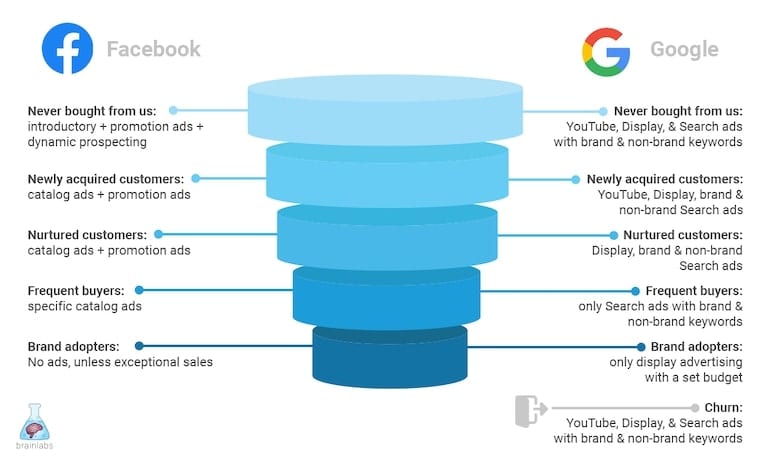Imagine being an e-commerce brand, which has been able to generate awareness and acquire a significant amount of customers after being around for a good period of time. You probably realize at some point that whether it is in paid search or social ads, you could be advertising to people who would be buying from you anyways. This is the beginning of a conversation that can lead to even more questions such as:
- How do I make sure to only deliver ads when it is needed and not pay extra money for acquired customers?
- How much am I willing to spend on acquired customers to ensure they do not leave?
- How much am I willing to pay for new customers?
- How do I create a clear separation between new and existing customers?
- Which strategy can I deploy for new vs existing customers?
- How do I understand how paid search vs paid social interact? Which one is more important for me?
While it is not possible to answer all of these questions since it all depends on your specific case, it may be possible to set up a campaign structure that would lay the foundation for you to be able to overcome these challenges.
The Campaign Structure
The following structure relies on two premises that need to hold true for your business in order for you to be able to deploy it:
- A customer is acquired through a first purchase, nurtured with the brand message or product quality, becomes a frequent buyer of your products, and finally turns into a full brand adopter who buys from you by default.
- You have the ability to create custom lists based on the criteria mentioned in the first premise: Newly acquired customers, Nurtured customers, Frequent Buyers, Brand adopters, Churn customers.
The goal is to build campaigns in both search and social platforms all segmented by the audiences mentioned above using dynamically updated customer lists, therefore achieving the following:
- The ability to create well-defined customer lists for each stage of your funnel
- The ability to cycle a customer through the funnel and eventually stop or minimize advertising once he reaches the brand adopter stage.
- The ability to combine paid search and paid social efforts by defining an articulated strategy based on the specific audiences mentioned above.
- The ability to report high-level on spend, revenue, and ROAS for each audience, therefore better understanding attribution and incrementality.
- The ability to understand Cost/acquisition, the cost of nurturing, the cost for maintaining frequent buyers, and the cost of staying top of mind for brand adopters.
Let’s see how that would work with a real business example.
A Practical Example
We consider the following e-commerce company:
- Name: Toys for pets
- Average customer purchase frequency: Once every 3 Months
- Advertising Platforms: Google and Facebook
Now…let’s get to work.
Step One – Creating dynamically updated lists for Newly acquired customers, Nurtured customers, Frequent Buyers, Brand adopters, Churned customers.
- Newly acquired customers: People who have recently entered our customer base with their first purchase
- Nurtured customers: People who have made only exactly between 2 or 3 purchases within L365D
- Frequent Buyers: People who have completed at least 4 purchases within L365D
- Brand Adopters: People who have made at least 7 purchases during the last 2 years.
- Churned Customers: People who have not made a purchase during a year
Step Two – Define a strategy for each audience and platform

How exactly you decide to set up the segmentation is dependent on your case, the size of the audiences you have and the amount of control you want on each audience. In Facebook, you might decide for example that you just want to have these audiences at the campaign level and not the ad set due to the way Facebook optimizes for results. In Google ads, you might realize that the brand adopters or other remarketing segments are not large enough for them to have their own campaign, so layering on the audiences with aggressive bid adjustment might do it.
Step 3 – Launch, Enjoy, Report
Once this is all set up, you should have the ability to report on spend for each audience by combining the cost on each platform and use internal data in order to report on revenue. That allows you to understand what your ROAS has been for each audience, which helps with setting goals and allocating budget. The possibilities in terms of insights are endless: understanding whether it makes sense for you to bid on brand keywords when it is a newly acquired customer vs a brand adopter, understanding what it takes to reactivate churned customers, understanding which non-brand queries your frequent buyers search for so that you can know what their needs are etc…
It Might be a Big Change in Your Account But…
You do not have to change anything yet. You can start by creating audiences with Google Analytics or Facebook ads based on the criteria mentioned above in order to start gathering insights about your funnel. That will help guide the discussion about whether or not, such a setup is worth it for your account. Never hurts to collect data!




